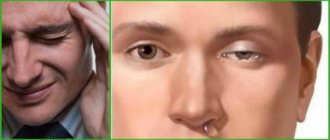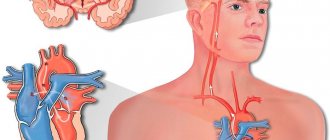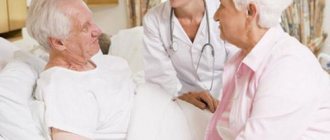21.02.2017
Pinchuk Elena Anatolyevna
Deputy chief physician for medical work, kmn, neurologist, doctor of physical and rehabilitation medicine
Maltseva Marina Arnoldovna
Head of the consultation department - neurologist, specialist in the field of extrapyramidal pathologies, doctor of the highest category
Kritskaya Olga Pavlovna
Neurologist, highest category
The term stroke is understood as an acute disorder of cerebral circulation with a persistent decrease or complete loss of certain body functions. A stroke can be a focal stroke (micro-stroke) or extensive, in which paresis can occur, most often of one half of the body. A condition in which a person experiences weakness or complete lack of movement in the left or right half of the body is called hemiparesis. Paralysis of the left side or paralysis of the right side during a stroke often occurs as a result of rupture of a cerebral artery, if qualified help is not sought in a timely manner.
Recovery from paralysis after stroke
Paralysis after a stroke indicates that ischemia or even necrosis of a large area of the cerebral cortex has occurred. If paralysis develops, the victim needs immediate, highly qualified medical care, which can be obtained at the Clinical Institute of the Brain, which employs highly qualified neurological and vascular specialists. Treatment largely depends on topical diagnosis and determination of the form of stroke. Treatment can be carried out conservatively or operatively (surgically).
Often, a paralyzed person after a stroke needs surgery, which consists of making a burr hole in the skull to avoid serious complications associated with compression and dislocation of the brain.
What is paresis?
Paresis is a pathological condition that is associated with impaired movement due to muscle weakness and disruption of nerve function. A person living with paresis may partially or completely lose only some voluntary movements in a certain limb (arm, leg) or other part of the body. The name given to the paresis varies depending on the part(s) of the body affected. For example:
- paraparesis means that both limbs (usually the arms) suffer from weakness and impaired voluntary movement;
- hemiparesis refers to paresis on one side of the body (arm and leg);
- tetraparesis – loss of movement in both arms and legs.
- Paresis is not limited to the limbs; it can also affect the vocal cords, stomach, eyes and other parts of the body.
A less used term is general paresis. This concept refers to paresis of the entire body, which occurs when syphilis is left untreated for a long time. However, this term is hardly used anymore because modern treatments have virtually eliminated this type of paresis.
Causes of paresis
What can cause paresis? Here are some examples: Spinal cord injury (spinal injury).
Not all back injuries lead to paresis.
A partial injury may allow a person to move very little. Specific nerves may remain intact, causing weakness but not complete paralysis. Stroke.
Although sometimes a stroke can cause brain damage severe enough to result in paralysis, sometimes the damage is slightly less and the result is only paresis.
Pinched nerve or sciatica.
This is one example of a pinched nerve leading to paresis.
If sciatica is severe enough, the person may have trouble feeling or moving one leg or foot. This can lead to weakness in one leg, which can make walking difficult. Damage to peripheral nerves.
Sometimes the nerves are damaged in the limb itself rather than in the brain or spine.
An injury can impair the function of a specific limb or other part of the body. Complication of surgical interventions.
After surgery, you may find that the muscles at the surgical site do not respond as fully or quickly as before surgery.
Although physical therapy can help some patients regain most of their motor function, for other patients the paresis becomes a permanent condition. In such cases, physical therapy or vocational rehabilitation can help preserve the muscle function that the tissue still retains. Doctors can teach a person to perform daily tasks independently despite paresis.
What is paralysis?
If paresis is weakness, partial loss of function, which eliminates some or all voluntary movement in a part of the limb, then paralysis (plegia) is the worst level of paresis. This is a condition where all movement in the affected region becomes impossible.
- Tetraplegia is the medical term for complete paralysis. Consequently, a person living with paralysis does not have the ability to voluntarily move a single limb.
- Hemiplegia involves paralysis on one side of the body (arm and leg).
- Paraplegia is an impairment of either the upper or lower extremities.
- Monoplegia is paralysis of one limb or part of the body.
As with paresis, many parts of the body can be affected and become completely paralyzed. There are also a number of different conditions that, along with spinal injury, can cause paralysis. Let's discuss some of these causes of paralysis.
Causes of paralysis
Most causes of paralysis fall into one of four categories: Spinal cord injury.
If the spinal cord is severed in any area, it cuts off communication with nerves in certain parts of the body.
The location of the spinal cord injury will determine how much of the body can no longer move voluntarily. Stroke.
The severity of the stroke, combined with damage to part of the brain, will determine the extent and location of paralysis.
Paralysis after a stroke most often affects one side of the body (opposite the lesion). Multiple sclerosis.
As multiple sclerosis progresses, the body causes more and more damage to its own nerves.
As nerves are damaged and scar tissue forms, paralysis can occur. Cerebral paralysis.
Depending on the location of the brain damage, cerebral palsy can result in varying degrees and locations of paralysis. This is not a comprehensive list of all possible causes of paralysis, but many people living with complete paralysis or some other form of movement disorder fall into one of these four categories.
Naturally, paralysis or paresis affects a person’s life in the most direct way. What can you do to lead a full life, and not just survive?
Living with paralysis or paresis
The fact is that the loss of any voluntary movement can affect a person in the same way as the loss of any part of the body.
Our body gives us the opportunity to live in the full sense of the word. And every function of the body matters. If your body is not feeling well, no matter how psychologically healthy you are, it will not allow you to function normally. It is imperative that a person maintains their body in proper condition and therefore takes the necessary steps to achieve the highest possible functionality. There are methods of compensatory movement, in which the function of the lost nerves and muscles is taken over by neighboring ones. It is on this principle that the author’s technique is based on Valentin Dikul, who fell in the circus while performing a trick from a great height and was paralyzed. He forced the living tissues of the body to take over the functions of the lost ones and was able to get up and walk. And this is not a miracle, but the enormous will and systematic work of a person who did not want to end his life in a wheelchair. His example inspires millions of people around the world! Text: Alena Paretskaya.
First aid
This involves hospitalizing the victim as quickly as possible. To do this, when identifying signs of a stroke, you must first report the incident to the emergency medical service and call a specialized team. It is necessary to provide the patient with rest, a supine position and an influx of fresh air. At home, it is unlikely that anything can be done to prevent the progression of a stroke. Only early initiation of drug therapy or surgery can prevent serious health consequences from a stroke.
Clinical Brain Institute Rating: 3/5 — 11 votes
Share article on social networks
Features of a left hemisphere stroke
The main features of a left hemisphere stroke are paralysis of the right limbs, difficulties with the speech apparatus and disruption of the human motor system. Stroke occurs in a predominant number of cases in patients suffering from diabetes, overweight people and those whose cholesterol in the body exceeds the norm. It is worth noting that with a stroke of the left hemisphere, the first symptoms appear on the right side. Scientifically speaking, during a stroke, brain cells die and neural connections are affected.
It must be said that left-sided stroke appears gradually, it has two stages. At the first stage, a person feels excessive sweating and increased heart rate - it is called an ischemic attack and lasts several minutes. If no action is taken, the second, more severe stage occurs. Then the person experiences fainting or semi-fainting, and nausea.
Functions of the left hemisphere
- Speech, memorizing words, learning other languages;
- Letter;
- Reading;
- Check;
- Good mood (joy, friendliness, happiness, goodwill);
- Motor functions of the right side of the body;
- Humor;
- Logical thinking;
- Extraordinary thinking;
- Reading maps and diagrams;
- Memorization;
- Chronological order of events that occurred;
- Future plans;
- Detailed consideration of situations;
- Formulating a question, problem, task;
- Active in conversations, desire to communicate;
- Assessment of situations and events;
- Optimistic view of the world;
- Linear representations;
- Analysis;
- Interpreting words or phrases through signs and symbols;
- Structure;
- Predictability;
- Sequential information processing.
Expert opinion
Author: Georgy Romanovich Popov
Neurologist, Candidate of Medical Sciences
In the structure of mortality, stroke ranks third after heart attacks and cancer. As a result of acute cerebrovascular accident, loss of ability to work develops. In 20–30% of cases, patients lose it completely. According to WHO statistics, 30% of strokes are fatal. Impaired cerebral circulation leads to disability. More than 60% of patients become disabled, 10% lose the ability to self-care. Such statistics are disappointing because recently doctors have been recording the occurrence of stroke at a young age.
Diagnosis of left-sided lesions is made much more often. This form of pathology has characteristic clinical signs in contrast to right-sided lesions. The Yusupov Hospital uses the latest CT and MRI equipment for examination. This is an informative way to quickly determine the location of the pathological focus and the degree of damage to brain tissue. Qualified neurologists at the Yusupov Hospital develop an individual treatment plan. Each patient is provided with preventive recommendations. Compliance with medical prescriptions can speed up recovery and reduce the risk of another stroke.
Programs:
Assessment of rehabilitation potential
Movement restoration
Rehabilitation after stroke
Restoration of cognitive functions
Early (resuscitation) rehabilitation







